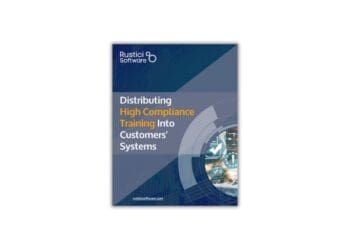A Gallup survey last year found that among employees who had received training on ethics and compliance, fewer than one in four rated the session as excellent. If you’ve seen the worst of the worst when it comes to compliance training, it’s not hard to see why. Ethics and compliance consultant Calvin London has a modest proposal: It’s time to rethink training altogether.
Most corporations use the term “training” as a catch-all. Employees respond with, “Not another training session” and end up with a negative mindset. Introducing compliance education rather than resorting to compliance training may have advantages that you have not yet considered.
Throughout my 40 years in quality and compliance, I have always pondered the use of the term “training” when it comes to compliance. Let’s start with dictionary definitions, which provide important clarity. Education is, “the process of gaining knowledge, skill and development from study or training.” Training, on the other hand, is defined as “the process of learning the skills one needs to do a particular job or activity.”
The skills and knowledge acquired through education tend to be more theoretical and help to develop reasoning and judgment surrounding broad topics. It is typically a more protracted timeline, and in terms of compliance, satisfies the need for repeated reminders of what compliance is or should be all about over multiple years.
Training, on the other hand, refers to the acquisition of specific and applied knowledge and skills. It can occur in a variety of settings, including a classroom setting, or preferably takes place on the job or in the field. Its purpose is to improve performance and productivity among employees, typically with a focus on one set of skills. Although some training courses can last multiple weeks, training courses are usually of a much shorter duration than educational programs because training encompasses more specific and focused topics.
5 Tips to Gain Compliance on Your Compliance Training
We know that compliance doesn’t necessarily equal security and that training employees is vital to preventing cyber attacks. But a poorly trained worker is the same as one not trained at all, and in too many tech companies, training isn’t exactly exciting or inspiring.
Read moreThere is a lot to be said about changing the perception of compliance training and instead offering compliance education. After all, don’t we want to impart knowledge to employees to know the difference between right and wrong? Don’t we want employees to understand how to interpret a Code of conduct or regulation rather than be able to list all of the components but not really understand how to interpret them?
In a recent Navex Risk & Compliance Benchmark report, almost half of participating companies (48%) indicated that training employees on policies was one of the top three challenges for them. Delivering compliance education instead of or in addition to routine training can be of great benefit to an organization.
Here are some advantages of changing perceptions:
- Perspective: By design, training has a narrow intent; education has a broader intent. The former teaches skills associated with a particular task. An employee is trained to fill out a form correctly or to operate a piece of equipment correctly in order to create consistency. We don’t train employees to read a regulation or a code of conduct in the same way, as each employee will have a different style. What we want them to achieve is an understanding of how to interpret and apply the code or regulation. Good compliance officers have the ability to interpret regulations and adapt them to the situation they are in. Compliant employees need to know which pathway to take and have the ability to choose the right one. Such learning is not delivered by standard training, because each situation may well be different.
- Objectivity: Training improves performance and productivity; education imparts a sense of reasoning and judgment and addresses general concepts and skills. For example, you can train employees not to take bribes. That is simple: Do not take bribes, end of training. Employees also need to know what constitutes a bribe and why they should not accept or give them.
- Duration: Education provides the opportunity for long-term benefits compared to training, which is aimed at a shorter duration.
- Long-term outcomes: Both training and education are forms of learning, but a skill learned through training, such as how to fill out a form or how to operate a piece of equipment, will need to be repeated every time the form or equipment changes. Education, because it is broader in its intent, provides learning that accumulates and assists in employee development.
There is little room for interpretation with training, which is the antithesis of what we want our employees to do when it comes to compliance. Granted, we want to develop a common level of understanding of the company’s position on compliance and the significance it (hopefully) places on it, but we also want employees to know how to interpret the difference between right and wrong.
I am not suggesting that there is no place in compliance for training. Rather, the benefits of education can significantly enhance your compliance position through a change in attitude. Many companies will shudder at the thought of providing more than the minimum requirement, based on the degree of difficulty in conducting additional education, and the time that it takes, pulling employees away from their “real” jobs.
One of the best ways, from my experience, to impart compliance education is to tap into the continual flow of bad compliance examples. These can be readily sourced by subscribing to publications such as this one and extracting the lessons learned. One of the characteristics of human behavior is that we seem to like to hear about bad news. Your employees will be no different. Ask them if they would prefer to hear about how Elizabeth Holmes went from riches to rags, how Wells Fargo earned a reputation of a rotten culture, how a whistleblower was awarded $14 million, how Facebook came to be fined $18 million for data privacy breaches — or navigate through several sessions on the respective codes that have been breached?
I once ran a series of exposes called the “dirty dozen” that analyzed the compliance and ethical breaches of 10 companies or individuals. It was a big success and I dare say imparted much more knowledge about compliance. It also provided opportunities for employees to express their opinions and to actually think about each situation.
Education does not have to be long or detailed. I have successfully delivered short, sharp compliance messages (micro-training), through things like moments of truth, soundbites or memory joggers. These can be short, factual statements followed by a multiple-choice question or you can relate the headlines of a real-life example. Using these over a long period provides continual exposure to the topic and builds knowledge that is more likely to be retained.
Again, in the Navex report, less than 50% of respondents indicated they were either good or excellent at providing systems for employees to ask questions about training, and less than 30% offered any form of micro-training (sorter more targeted training).
Moving away from traditional forms of training and embracing compliance education, rather than feeding information and hoping for the best, will breathe new life into your compliance program, which your employees will thank you for. Providing them with the opportunity to develop skills in compliance interpretation is part of a forward-thinking and progressive company.




 Calvin London, Ph.D., is the Founder and Principal consultant at
Calvin London, Ph.D., is the Founder and Principal consultant at 










